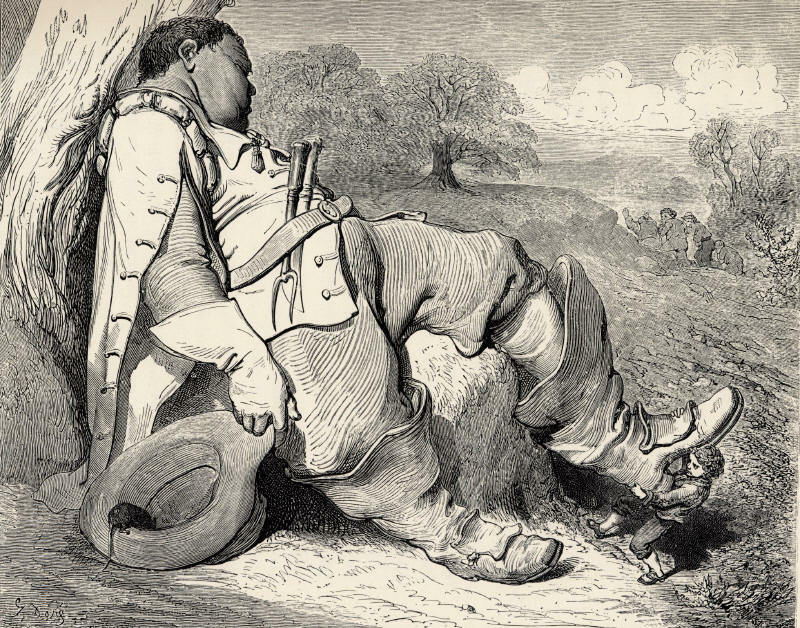
Illustration: Hop-o'-My-Thumb, by Gustave Doré, 1862
{Image description: Engraving of a very big man sleeping leaning against a tree. In the bottom right corner a very tiny boy takes one of the giant's big boots off. The background is a field with a couple of trees and there'a a small group of children hiding and watching the scene.}
*
The cleverness and mental agility of the little boy who is no bigger than a thumb remind me of the sign of Gemini, always curious, but so restless and volatile. Like so many other tales, Hop-o’-My-Thumb has several versions. However, more than just versions, this character also unfolds in different stories and in some of them even seems to borrow themes from other tales. For example, in Charles Perrault's tale, published in the book Tales of Mother Goose in 1697, Hop-o’-My-Thumb — or Little Thumbling, as it is also called sometimes — repeats a theme from Hansel and Gretel, the children who are abandoned in the forest by their parents, but also the idea of leaving a trail, first of stones and then of crumbs, to be able to return home.
The Grimm brothers have two stories starring the little hero, Hop-o’-My-Thumb and Thumbling’s Travels, published in various editions of Grimm's Fairy Tales in the first half of the 19th century. In the latter, the tiny boy is the son of a tailor and goes off into the world in search of adventures, evocative of the tale The Brave Little Tailor, by the same authors. There is also an English tale, recovered by Joseph Jacobs, which intertwines this character with the legend of King Arthur. Not forgetting Thumbelina, by Hans Christian Andersen, in which butterflies, swallows, and other winged beings, all Gemini creatures, play a determining role in the destiny of the protagonist.
Like Gemini, Little Thumbling is always described as clever, agile and versatile, and with great flexibility, able to adapt to various environments and contexts. This sign is of the Air element and mutable in modality, it plays with ideas. Mercury, its ruler, is the archetype of the trickster, the illusionist, who bewilders us and confuses our line of thought. And if everything in life is a matter of perspective, then Gemini wants to try every single possible point of view.
The Brothers Grimm's tale Hop-o’-My-Thumb begins with a couple expressing their desire to have a child, even if he was as tiny as the size of a thumb. Gemini is the first Air sign and reminds us of the importance of words. If our beliefs shape our reality, the word is the beginning of that manifestation. The wish is granted, just as it was requested, and the couple gets a boy who never grows bigger than a thumb, who they call Hop-o’-My-Thumb. Gemini may seem light and inconsequential, but words have strength, they carry with them the ability to name things and thus bringing them into existence, inside and outside of us.
One day, the little boy decides to help his father taking the cart to the forest, but his father found it difficult for Hop-o’-My-Thumb to be able to accomplish this task, because, being so tiny, he would not be able to hold the reins. However, the next day, the mother saddled the horse and put her tiny son by the animal's ears. Giving precise orders, Hop-o’-My-Thumb drives the wagon to his father, reminding us again of the power of words. In both of the Grimm's tales the little hero encounters some thieves, thwarting them in one of the stories and collaborating with them in the other. The thieves, ruled by Mercury, also fit the energy of Gemini. Cunning and astute, they are quick and agile, using their fingers like a prestidigitator. They also show amorality, a lack of principles, implicit in their activity of changing things from their places and owners.
But Perrault's tale is the only one that shows a development of the protagonist. I confess that when I was doing research to write this article, I was displeased by the feeling of déjà vu at the beginning of this story. But as I was analyzing the tales and writing about the character, I realized that this is the only tale in which Hop-o’-My-Thumb truly grows and evolves. In Charles Perrault's narrative, the little boy is not only small in stature, but he is the youngest of seven sons, and to compensate for this apparent disadvantage, he will become the most agile and the smartest of them all. The comparison with the brothers reinforces the Gemini symbolism, as Mercury also rules siblings.
When the boys find themselves lost in the forest, a strong wind arises and they feel very afraid. The wind is an element of instability and change, it brings us nervousness and restlessness. And so is the Gemini energy, impatient and anxious, always jumping up and down, never really able to stop and settle down. Hop-o’-My-Thumb then decides to climb a tree and, after seeing a light, leads his brothers in this direction.
They arrive at a house where a giant’s wife meets them. She warns them that her husband would eat them if he found them. After some misadventures, which include an exchange of roles between the seven brothers and the seven daughters of the giant, Hop-o’-My-Thumb and his brothers end up escaping. But the giant follows them with the help of his Seven-league boots, magical boots that make him walk very fast. Traveling and small journeys are also under the rule of Mercury. This planet’s restlessness and agitation means that these people are always on the move, but in the end they never stray too far from their familiar surroundings.
To stop the chase, Hop-o’-My-Thumb takes advantage of a moment when the giant is sleeping and, without waking him up, takes off his boots very lightly (I have already talked about the thieves and their abilities above) and puts them on himself. With these magic boots he puts himself at the service of a king as his messenger and makes a great fortune at this trade, later returning home, where he and his family never again suffered any need. Mercury was himself the messenger of the gods and that is Gemini's main function, to communicate, to spread information and to make connections.
The various Little Thumblings of the Grimm Brothers show little or no learning throughout their respective stories and they illustrate some of the less positive aspects of Gemini, shallowness, fickleness and nonsense. Perrault's little hero, on the other hand, begins as the youngest, smallest, and seemingly most ignorant of the brothers and, during the course of the narrative, is revealed as the most cunning, cleverest, and most resourceful, achieving success and sharing it with his siblings and parents. Overcoming his frivolous and inconsequential side, his nervousness and agitation, Gemini finds their purpose, exchanging ideas and disseminating information, but acting with the neutrality, detachment, and lightness of a breeze that does not forget to play with the leaves along the way.
*
2014
